In vivo bone regeneration assessment of offset and gradient melt electrowritten (MEW) PCL scaffolds
- PMID: 33014414
- PMCID: PMC7529514
- DOI: 10.1186/s40824-020-00196-1
In vivo bone regeneration assessment of offset and gradient melt electrowritten (MEW) PCL scaffolds
Abstract
Background: Biomaterial-based bone tissue engineering represents a promising solution to overcome reduced residual bone volume. It has been previously demonstrated that gradient and offset architectures of three-dimensional melt electrowritten poly-caprolactone (PCL) scaffolds could successfully direct osteoblast cells differentiation toward an osteogenic lineage, resulting in mineralization. The aim of this study was therefore to evaluate the in vivo osteoconductive capacity of PCL scaffolds with these different architectures.
Methods: Five different calcium phosphate (CaP) coated melt electrowritten PCL pore sized scaffolds: 250 μm and 500 μm, 500 μm with 50% fibre offset (offset.50.50), tri layer gradient 250-500-750 μm (grad.250top) and 750-500-250 μm (grad.750top) were implanted into rodent critical-sized calvarial defects. Empty defects were used as a control. After 4 and 8 weeks of healing, the new bone was assessed by micro-computed tomography and immunohistochemistry.
Results: Significantly more newly formed bone was shown in the grad.250top scaffold 8 weeks post-implantation. Histological investigation also showed that soft tissue was replaced with newly formed bone and fully covered the grad.250top scaffold. While, the bone healing did not happen completely in the 250 μm, offset.50.50 scaffolds and blank calvaria defects following 8 weeks of implantation. Immunohistochemical analysis showed the expression of osteogenic markers was present in all scaffold groups at both time points. The mineralization marker Osteocalcin was detected with the highest intensity in the grad.250top and 500 μm scaffolds. Moreover, the expression of the endothelial markers showed that robust angiogenesis was involved in the repair process.
Conclusions: These results suggest that the gradient pore size structure provides superior conditions for bone regeneration.
Keywords: Angiogenesis; Bone tissue engineering; Melt electrowriting; Poly (ε-caprolactone); Pore size; Scaffold.
© The Author(s) 2020.
Conflict of interest statement
Competing interestsThe authors declare that they have no competing interests.
Figures




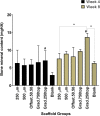
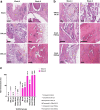
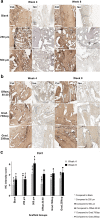
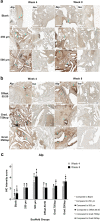
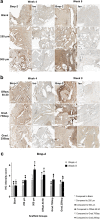
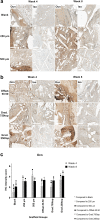
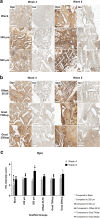
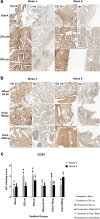
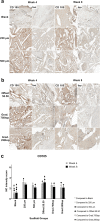
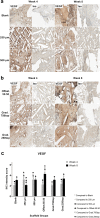
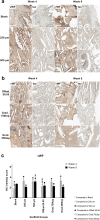
Similar articles
-
Role of offset and gradient architectures of 3-D melt electrowritten scaffold on differentiation and mineralization of osteoblasts.Biomater Res. 2020 Jan 3;24:2. doi: 10.1186/s40824-019-0180-z. eCollection 2020. Biomater Res. 2020. PMID: 31911842 Free PMC article.
-
Effects of Gradient and Offset Architectures on the Mechanical and Biological Properties of 3-D Melt Electrowritten (MEW) Scaffolds.ACS Biomater Sci Eng. 2019 Jul 8;5(7):3448-3461. doi: 10.1021/acsbiomaterials.8b01456. Epub 2019 Jun 18. ACS Biomater Sci Eng. 2019. PMID: 33405729
-
Melt Electrowritten Sandwich Scaffold Technique Using Sulforhodamine B to Monitor Stem Cell Behavior.Tissue Eng Part C Methods. 2020 Oct;26(10):519-527. doi: 10.1089/ten.TEC.2020.0240. Tissue Eng Part C Methods. 2020. PMID: 32977739
-
The effect of pore size within fibrous scaffolds fabricated using melt electrowriting on human bone marrow stem cell osteogenesis.Biomed Mater. 2019 Nov 8;14(6):065016. doi: 10.1088/1748-605X/ab49f2. Biomed Mater. 2019. PMID: 31574493
-
Advances in melt electrowriting for cardiovascular applications.Front Bioeng Biotechnol. 2024 Sep 17;12:1425073. doi: 10.3389/fbioe.2024.1425073. eCollection 2024. Front Bioeng Biotechnol. 2024. PMID: 39355277 Free PMC article. Review.
Cited by
-
Non-invasive in vivo monitoring of transplanted stem cells in 3D-bioprinted constructs using near-infrared fluorescent imaging.Bioeng Transl Med. 2021 Mar 26;6(2):e10216. doi: 10.1002/btm2.10216. eCollection 2021 May. Bioeng Transl Med. 2021. PMID: 34027098 Free PMC article.
-
Integrating Melt Electrowriting and Fused Deposition Modeling to Fabricate Hybrid Scaffolds Supportive of Accelerated Bone Regeneration.Adv Healthc Mater. 2024 Jan;13(3):e2302057. doi: 10.1002/adhm.202302057. Epub 2023 Nov 16. Adv Healthc Mater. 2024. PMID: 37933556 Free PMC article.
-
FLIM imaging revealed spontaneous osteogenic differentiation of stem cells on gradient pore size tissue-engineered constructs.Stem Cell Res Ther. 2023 Apr 12;14(1):81. doi: 10.1186/s13287-023-03307-6. Stem Cell Res Ther. 2023. PMID: 37046354 Free PMC article.
-
Niche-inspired collagen infused melt electrowritten scaffolds for craniofacial bone regeneration.Biomater Adv. 2025 May;170:214222. doi: 10.1016/j.bioadv.2025.214222. Epub 2025 Feb 6. Biomater Adv. 2025. PMID: 39923603
-
Applications of Engineering Techniques in Microvasculature Design.Front Cardiovasc Med. 2021 Apr 26;8:660958. doi: 10.3389/fcvm.2021.660958. eCollection 2021. Front Cardiovasc Med. 2021. PMID: 33981737 Free PMC article. Review.
References
-
- Rohman G, Langueh C, Ramtani S, Lataillade JJ, Lutomski D, Senni K, et al. The use of platelet-rich plasma to promote cell recruitment into low-molecular-weight Fucoidan-functionalized poly(Ester-urea-urethane) scaffolds for soft-tissue engineering. Polymers-Basel. 2019;11(6):1016. doi: 10.3390/polym11061016. - DOI - PMC - PubMed
-
- Woodruff MA, Hutmacher DW. The return of a forgotten polymer-Polycaprolactone in the 21st century. Prog Polym Sci. 2010;35(10):1217–1256. doi: 10.1016/j.progpolymsci.2010.04.002. - DOI
LinkOut - more resources
Full Text Sources
Miscellaneous

